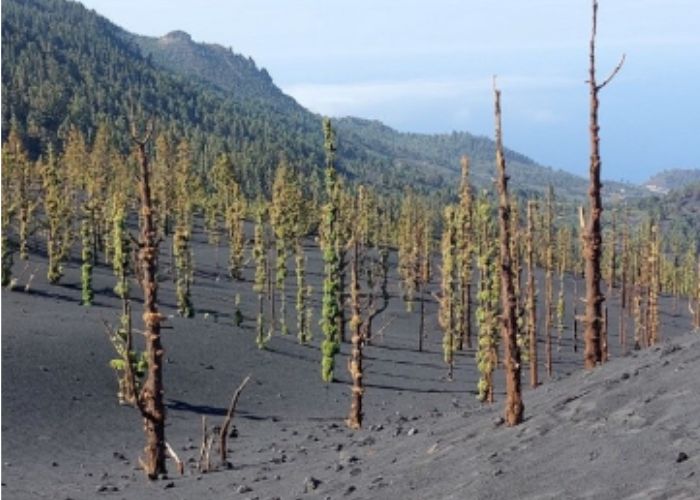LA PALMA – The speed at which biodiversity is recovering in the area of La Palma affected by the volcanic eruption astonishes scientists. They call the adaptability of some species, both plant and animals “incredible”.
A team of scientists led by the CSIC is working with a technician from the island government and a biologist from the public company Gesplan to monitor the area around the volcano Cumbre Vieja on the Canary Island of La Palma after the eruption last September. Manuel Nogales, one of the scientists admits in Diario de Canarias that he thought the flora and fauna would “take longer” to move forward after something as extreme as a volcanic eruption.
Pine trees already sprouting
For example, there are pine trees in the first 500 metres closest to the volcano that already started sprouting a month after the end of the eruption. Green has even sprouted up again in species that were on the extreme rim of the volcano’s interior. Despite this, about 70% of those pines probably won’t make it, according to Nogales because they’ve dried out over the summer.
He explains that pine trees germinate by special (parenchymal) cells, which can withstand high temperatures. The key is only whether the root resisted or is charred. The latter is probably the case with the specimens so close to the crater. Beyond those 500 metres, the pine forest’s degraded foliage is now 20%, up from 100%, the scientist said. The appearance of the pine forest has changed from “complete brown” to khaki in spring and “perfect green” in late summer.
Mapping out the state of vegetation and fauna
The team of scientists spent nine months analysing the evolution of biodiversity on the island and around the volcano. They periodically map out the state of vegetation and fauna in defined zones.
One of these areas is the pine forest, most affected by the release of gases during the eruption. This extends from the cone of the volcano to seven kilometres. Another area runs along the edge of the lava and flows 200 metres from the cone to the sea. The researchers are not working on the lava flows because “there is almost no life there, it is too hot”.
By observing the flora, they were able to verify that the plants with a woody appearance, such as sun roses, broom, heather and tedera, are the only ones that have been able to survive near the crater.
A little further afield is an abundance of verodes, brooms and tabaibas, but the herbaceous ones have disappeared, either from the heat or from being buried under the tons of ash spewed from the volcano.
Lizards worst affected
This lava ultimately has consequences for the fauna, especially for reptiles and lizards. On the one hand, the ashes covered many of their hiding places, so some couldn’t get out and died. Others were unable to hide, making them easy targets for birds of prey. Still, others died of starvation instantly because the vegetation or insects they fed on disappeared in the “ecological collapse.”
Dragonflies, grasshoppers and winged beetles
Invertebrates are still “very scarce” in the area closest to the volcano. Only large specimens or good flying specimens can be seen here, such as dragonflies, grasshoppers and some winged beetles. The birds, Manuel Nogales emphasises, “escaped better” thanks to their mobility. Some species, such as the common finch, took about four months to return to their habitats.
In the coastal strip, the gulls adjusted their diet “almost daily”, depending on “what the volcano killed” and what was left: crabs, limpets or fish. That same “trophic plasticity” was exhibited by kestrels. In the absence of lizards, they began to prey on other birds.
An evolutionary laboratory
Manuel Nogales emphasises the fact that the researchers can now verify things that were not possible until now. The area affected by the volcanic eruption is now an evolutionary laboratory. In addition, there are other works on La Palma to predict how long it will take for the areas flooded by lava to recover.
Related post: This is how the reconstruction of La Palma is going a year after the volcanic eruption


